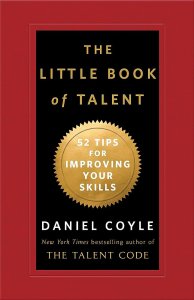The Little Book of Talent by Daniel Coyle is a practical companion to his first book on the topic, The Talent Code, which argues that talent (innate ability) has little bearing on skill acquisition and enhancement. Rather, Coyle contends, the most “talented” among us are actually just the most committed to a formula that has consistently produced greatness in countless domains ranging from piano to tennis to mathematics and more—a formula that anyone can learn and apply to any activity they want to pursue.
Whereas The Talent Code is the textbook, The Little Book of Talent is the handbook—short, highly actionable chapters that tell you what to do to get better at skill building but not necessarily why it works. And so if you’re looking for a thorough, step-by-step treatment of the subject, this book isn’t for you, but if you want to skip the theory and get to the strategies, you’ll find a lot of value in these pages.
My Top 10 Takeaways from The Little Book of Talent by Daniel Coyle
1
“Talent begins with brief, powerful encounters that spark motivation by linking your identity to a high-performing person or group. This is called ignition, and it consists of a tiny, world-shifting thought lighting up your unconscious mind: I could be them.”
2
“We are often told that talented people acquire their skill by following their ‘natural instincts.’ This sounds nice, but in fact it is baloney. All improvement is about absorbing and applying new information, and the best source of information is top performers. So steal it.
“When you steal, focus on specifics, not general impressions. Capture concrete facts: the angle of a golfer’s left elbow at the top of the backswing; the curve of a surgeon’s wrist; the precise shape and tension of a singer’s lips as he hits that high note; the exact length of time a comedian pauses before delivering the punch line. Ask yourself: • What, exactly, are the critical moves here? • How do they perform those moves differently than I do?”
3
“The key to deep practice is to reach. This means to stretch yourself slightly beyond your current ability, spending time in the zone of difficulty called the sweet spot. It means embracing the power of repetition, so the action becomes fast and automatic. It means creating a practice space that enables you to reach and repeat, stay engaged, and improve your skills over time.
“[Comfort Zone] Sensations: Ease, effortlessness. You’re working, but not reaching or struggling. Percentage of Successful Attempts: 80 percent and above. [Sweet Spot] Sensations: Frustration, difficulty, alertness to errors. You’re fully engaged in an intense struggle—as if you’re stretching with all your might for a nearly unreachable goal, brushing it with your fingertips, then reaching again. Percentage of Successful Attempts: 50–80 percent. [Survival Zone] Sensations: Confusion, desperation. You’re overmatched: scrambling, thrashing, and guessing. You guess right sometimes, but it’s mostly luck. Percentage of Successful Attempts: Below 50 percent.”
4
“To begin chunking, first engrave the blueprint of the skill on your mind (see Tip #2). Then ask yourself: 1) What is the smallest single element of this skill that I can master? 2) What other chunks link to that chunk? Practice one chunk by itself until you’ve mastered it—then connect more chunks, one by one, exactly as you would combine letters to form a word. Then combine those chunks into still bigger chunks. And so on. Musicians at Meadowmount cut apart musical scores with scissors and put the pieces in a hat, then pull each section out at random. Then, after the chunks are learned separately, they start combining them in the correct order, like so many puzzle pieces.
“No matter what skill you set out to learn, the pattern is always the same: See the whole thing. Break it down to its simplest elements. Put it back together. Repeat.”
5
“With deep practice, small daily practice ‘snacks’ are more effective than once-a-week practice binges.”
6
“Super-slow practice works like a magnifying glass: It lets us sense our errors more clearly, and thus fix them.
“As the saying goes, ‘It’s not how fast you can do it. It’s how slowly you can do it correctly.’”
7
“One of the most fulfilling moments of a practice session is when you have your first perfect rep. When this happens, freeze. Rewind the mental tape and play the move again in your mind. Memorize the feeling, the rhythm, the physical and mental sensations. The point is to mark this moment—this is the spot where you want to go again and again.
“As Kimberly Meier-Sims of the Sato Center for Suzuki Studies says, ‘Practice begins when you get it right.’”
8
“Exhaustion is the enemy. Fatigue slows brains. It triggers errors, lessens concentration, and leads to shortcuts that create bad habits. It’s no coincidence that most talent hotbeds put a premium on practicing when people are fresh, usually in the morning, if possible. When exhaustion creeps in, it’s time to quit.”
9
“To learn a new move, exaggerate it. If the move calls for you to lift your knees, lift them to the ceiling. If it calls for you to press hard on the guitar strings, press with all your might. If it calls for you to emphasize a point while speaking in public, emphasize with theatricality. Don’t be halfhearted. You can always dial back later. Go too far so you can feel the outer edges of the move, and then work on building the skill with precision.”
10
“Solo practice works because it’s the best way to 1) seek out the sweet spot at the edge of your ability, and 2) develop discipline, because it doesn’t depend on others. A classic study of musicians compared world-class performers with top amateurs. The researchers found that the two groups were similar in every practice variable except one: The world-class performers spent five times as many hours practicing alone.”











